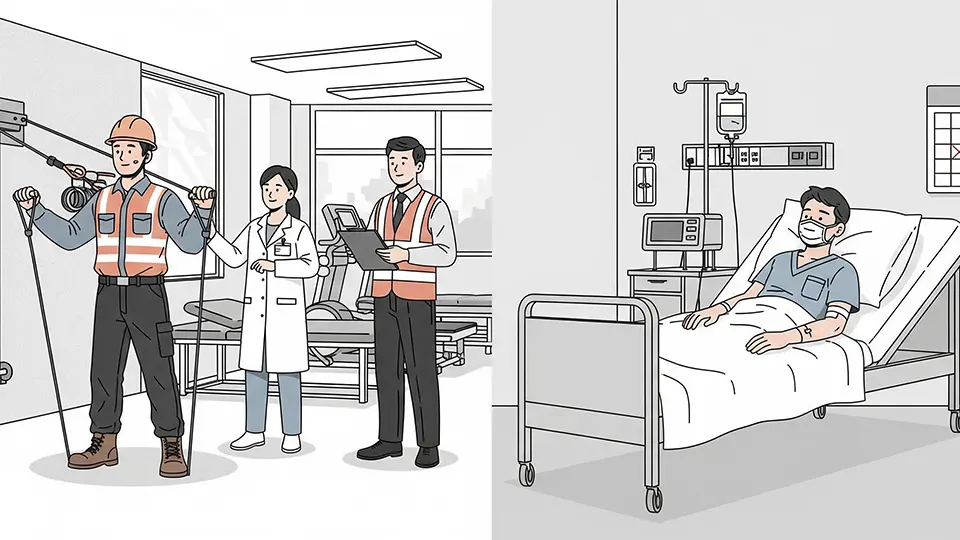Table of Contents
If you’re among the 100 million Americans struggling with joint pain, you face a pivotal choice that could define your quality of life for years to come. Should you pursue conservative treatment through physical therapy, or is surgical intervention your best path forward?

Groundbreaking 2024 research reveals that physiotherapy vs surgery outcomes are remarkably similar for most joint conditions-yet one option costs 15 times less and carries minimal risks. This comprehensive guide examines the latest evidence to help you make an informed decision about your treatment journey.
Key Takeaways: Physiotherapy vs Surgery at a Glance
Before exploring the details of conservative versus operative care, here’s what current research tells us:
- Clinical effectiveness: Both treatments achieve 65-80% success rates for common conditions
- Cost differential: Physical therapy costs $447-$1,297 versus $20,000-$74,000 for operations
- Recovery speed: Return to work in 0-2 weeks with rehabilitation versus 6-12 weeks post-surgery
- Complication rates: Less than 1% for conservative care versus 1-5% for surgical procedures
- Professional consensus: All major medical organizations recommend exhausting non-operative options first
When is Physiotherapy Better Than Surgery?
Knee Osteoarthritis and Degenerative Conditions

Recent systematic reviews have fundamentally changed our understanding of knee treatment. A 2024 BMC meta-analysis examining 1,411 patients found no significant differences between arthroscopic procedures and structured exercise programs for pain relief, functional improvement, or patient satisfaction.
The Cochrane Review’s analysis of 12,468 participants demonstrated that exercise therapy improves pain by 8.7 points and function by 11.3 points on standardized scales—comparable to surgical outcomes without the associated risks.
Meniscal Tears and Cartilage Damage

For degenerative meniscal tears, the evidence overwhelmingly supports conservative management. A network meta-analysis published in January 2024 concluded that physical rehabilitation should be the first-line treatment, with surgery reserved for specific mechanical symptoms or failed conservative care.
Rotator Cuff Pathology

Shoulder conditions show nuanced results. While small to medium tears respond excellently to rehabilitation (70-80% success), large acute traumatic tears may benefit from early surgical repair. The key finding: structured exercise programs achieve outcomes within 5.6 points of surgical repair on validated scales—a difference too small to be clinically meaningful.
Hip Conditions

Early to moderate hip osteoarthritis demonstrates significant improvement with targeted exercise interventions. Studies show sustained benefits at 6-9 months, effectively delaying or preventing the need for joint replacement in many patients.
Physiotherapy vs Surgery Success Rates: Head-to-Head Comparison
Physiotherapy Treatment Effectiveness

Physical therapy and exercise-based interventions achieve impressive results across conditions:
- Knee osteoarthritis: 70-75% meaningful improvement
- Meniscal degeneration: 65-80% avoid surgery entirely
- Rotator cuff tears: 70-80% return to full function
- Hip arthritis: 60-70% experience significant relief
- Chronic back pain: 75-85% improvement with structured programs
Surgical Intervention Outcomes

Operative procedures show varied success depending on the specific intervention:
- Total knee replacement: 85-90% satisfaction at 10 years
- Arthroscopic knee surgery: 65-75% improvement (similar to conservative care)
- Rotator cuff repair: 75-85% structural healing
- Hip replacement: 90-95% excellent long-term results
- Spinal fusion: 60-70% satisfactory outcomes

Schedule your physiotherapy consultation with Dr.Iqra Kiran today
The Cost Comparison: Physiotherapy vs Surgery Financial Analysis
Direct Treatment Expenses
The economic difference between conservative and surgical management is substantial:
Physical Therapy Costs:

- Initial comprehensive evaluation: $75-$150
- Follow-up sessions (12-20 visits): $50-$100 each
- Total episode cost: $447-$1,297
- Annual maintenance: $500-$1,000
- Insurance coverage: Generally excellent with low copays
Surgical Procedure Costs:

- Knee replacement: $16,981-$29,488
- Hip arthroplasty: $23,200-$74,000
- Arthroscopic procedures: $5,000-$15,000
- Surgeon fees alone: $1,375-$15,000
- Post-operative rehabilitation: Additional $2,000-$5,000
Hidden Financial Considerations
Beyond direct medical costs, consider:
- Lost productivity (0-2 weeks versus 6-12 weeks)
- Caregiver expenses and time off work
- Complication management costs
- Potential revision surgery (4% within 5 years)
- Long-term medication expenses
Recovery Timeline: Physiotherapy vs Surgery Comparison
Conservative Rehabilitation Phases

Weeks 0-2: Initial Phase Pain management, gentle movement, education about condition, activity modification strategies
Weeks 2-8: Strengthening Phase Progressive resistance training, flexibility work, functional movement patterns, gradual activity increase
Weeks 8-12+: Advanced Phase Sport-specific training, work simulation, maintenance program development, self-management skills
Most patients maintain normal activities with modifications throughout treatment.
Post-Surgical Recovery Stages

Days 1-3: Hospital Phase Initial mobilization, pain control, discharge planning, early physical therapy
Weeks 2-6: Protected Recovery Limited weight-bearing, wound healing, basic exercises, supervised rehabilitation
Weeks 6-12: Progressive Loading Increased activity, strength building, range of motion work, functional training
Months 3-6: Return to Activity Full weight-bearing, advanced exercises, sport/work preparation, long-term planning
Digital Revolution: How Telehealth Changes Physiotherapy

Virtual Physiotherapy: A Game-Changer
The emergence of telehealth has fundamentally altered the physiotherapy landscape. A 2024 systematic review in the Journal of Medical Internet Research found that telerehabilitation achieves 8% higher attendance rates and 9% better exercise adherence compared to in-person sessions.
Benefits of Virtual Physiotherapy:
- Accessibility: Eliminates travel barriers for rural or mobility-limited patients
- Consistency: Maintains treatment during weather events or health emergencies
- Cost savings: Reduces transportation costs and time off work
- Technology integration: Uses AI-powered movement analysis and real-time feedback
- Patient engagement: Gamified exercises increase adherence by 15-20%
Recent studies show 92% patient satisfaction with videoconferencing consultations, with 81% of physiotherapists planning to continue offering virtual options post-pandemic. This hybrid model combines the best of both worlds—hands-on assessment when needed with convenient follow-up sessions online.
Special Populations: Physiotherapy vs Surgery Considerations
Physiotherapy vs Surgery for Older Adults

Seniors face unique considerations when choosing treatment approaches. Adults over 65 show different risk-benefit profiles:
Conservative Management Advantages:
- Eliminates anesthesia risks
- Maintains independence during treatment
- Addresses multiple joints simultaneously
- Promotes overall conditioning and fall prevention
- Lower cognitive impact
Surgical Considerations for Elderly:
- Higher complication rates (3-5% versus 1-2%)
- Longer recovery periods
- Greater post-operative confusion risk
- Need for extensive support systems
- Excellent outcomes when appropriately selected (95% satisfaction)
Treatment Options for Athletes with Joint Pain

Athletic populations require specialized treatment protocols that consider performance demands:
Rehabilitation Benefits for Athletes:
- Maintains cardiovascular fitness throughout recovery
- Corrects biomechanical deficits preventing future injury
- Preserves proprioception and neuromuscular control
- Allows graduated return-to-sport protocols
- 85% successful return to recreational sports
Surgical Indications for Athletes:
- Complete ACL ruptures in pivoting sports
- Recurrent shoulder dislocations
- Large acute rotator cuff tears
- Failed conservative management after 6 months
- Time-sensitive professional contracts
Workers’ Compensation: Which Treatment Saves Money?

Occupational injuries present unique challenges and opportunities:
Conservative Care in Workplace Injuries:
- Enables modified duty programs (maintaining employment)
- Reduces claim costs by $15,000-$25,000 average
- Faster return to full duty (4-6 weeks versus 12-16 weeks)
- Lower permanent disability ratings
- Better long-term employment outcomes
Insurance data demonstrates that early physical therapy intervention within 14 days of injury reduces total claims costs by 60% compared to delayed treatment or surgical pathways.
Risk Factors: Understanding Safety Profiles
Conservative Treatment Risks

Physical rehabilitation carries minimal risks:
- Temporary exercise soreness (common, self-limiting)
- Rare symptom exacerbation (<5% of cases)
- No systemic complications
- No infection or anesthesia exposure
- Easily modified if problems arise
Surgical Complication Rates

Operative interventions involve inherent risks:
- Infection: 1-2% primary procedures, 4-5% revisions
- Blood clots: 0.5-1% incidence
- Anesthesia complications: Variable by health status
- Nerve injury: 0.1-0.5% depending on procedure
- Implant problems: 10-15% at 10 years
- Mortality: 0.1-0.3% within 90 days
What Medical Guidelines Recommend

Professional Organization Consensus
Every major medical body has published position statements favoring conservative care:
American Academy of Orthopaedic Surgeons (AAOS): “Minimum 3-6 months structured conservative treatment before considering elective surgery for degenerative conditions”
American Physical Therapy Association (APTA): “Exercise-based interventions are first-line treatment for musculoskeletal pain”
National Institute for Health and Care Excellence (NICE): “All patients should receive comprehensive conservative care with documented trials before surgical referral”
Osteoarthritis Research Society International (OARSI): “Education, exercise, and weight management are core treatments regardless of disease severity”
Who Should Consider Surgery First?

While conservative care is preferred initially, certain conditions warrant early surgical consultation:
Absolute Surgical Indications
- Complete ligament ruptures in young, active patients
- Progressive neurological deficits
- Fractures requiring fixation
- Tumor or infection
- Severe deformity affecting function
Relative Surgical Indications
- End-stage arthritis with bone-on-bone changes
- Failed quality conservative care (minimum 6 months)
- Mechanical symptoms (locking, giving way)
- Severe pain unresponsive to all conservative measures
- Significant quality of life impairment
Making Your Decision: A Practical Framework

Step-by-Step Decision Process
- Get accurate diagnosis through imaging and clinical examination
- Understand your condition’s natural history and prognosis
- Try conservative treatment for minimum 12 weeks
- Track progress objectively using validated outcome measures
- Reassess at 3 months with your healthcare team
- Consider surgery only if conservative care fails and criteria are met
Key Questions to Ask
- What percentage of patients avoid surgery with rehabilitation?
- What are the specific risks given my health status?
- How will each option affect my work and activities?
- What is the total cost including indirect expenses?
- What happens if the first treatment fails?
Breaking Down Barriers to Conservative Success

Common Misconceptions
“Surgery provides permanent solution” Reality: 15-20% require revision within 10-15 years, while exercise benefits can last indefinitely with maintenance.
“Physical therapy is too slow” Reality: Many achieve meaningful improvement within 4-6 weeks, faster than surgical recovery.
“Insurance won’t cover enough therapy” Reality: Most plans provide adequate coverage, and cost remains far below surgical expenses.
Access Solutions
- Geographic barriers: Telehealth options now available nationwide
- Time constraints: Early morning, evening, and weekend appointments
- Financial concerns: Payment plans and sliding scales available
- Transportation issues: Home health and mobile therapy expanding
Real-World Success Stories
Sarah, 58-year-old teacher with severe knee osteoarthritis:
- Started with 8/10 pain, difficulty with stairs
- 12-week structured exercise program
- Lost 15 pounds through integrated nutrition counseling
- Pain reduced to 3/10, returned to hiking
- Avoided $35,000 surgery, maintained improvement 2 years later
Case Study 2: Return to Sport Without Surgery
Marcus, 35-year-old soccer player with meniscal tear:
- MRI showed degenerative tear with mechanical symptoms
- 10-week progressive rehabilitation program
- Full return to competitive soccer
- Saved $15,000 in surgical costs
- Playing successfully 3 years post-treatment
Case Study 3: Rotator Cuff Recovery
Jennifer, 48-year-old nurse with partial rotator cuff tear:
- Unable to work due to shoulder pain
- 8-week targeted strengthening program
- Returned to full duty without restrictions
- Avoided surgery and 3-month recovery period
- Maintained improvement with home program
Complete Checklist Before Choosing Surgery
Have You:
☐ Obtained accurate diagnosis with appropriate imaging?
☐ Tried structured physical therapy for 12+ weeks?
☐ Attempted at least 2 different rehabilitation approaches?
☐ Addressed lifestyle factors (weight, sleep, stress)?
☐ Explored injection therapies if appropriate?
☐ Received second opinion from another provider?
☐ Calculated total costs including time off work?
☐ Understood all potential complications?
☐ Arranged post-operative support and rehabilitation?
☐ Exhausted insurance-covered conservative options?
Conclusion
The choice between physiotherapy vs surgery has been clarified by extensive research: conservative treatment offers comparable outcomes with lower costs and risks for most joint conditions. While surgical intervention remains valuable for specific indications, it should rarely be the first option.
By following evidence-based guidelines and working with qualified providers, you can optimize your outcomes while minimizing risks and expenses. Remember: you can always choose surgery later if needed, but you cannot reverse surgery once performed.
Start with conservative care-your body and bank account will thank you.
FAQ section about Physiotherapy vs Surgery
How long should I try physical therapy before considering surgery?
Evidence supports minimum 3-6 months of structured rehabilitation before surgical consideration for degenerative conditions.
Will insurance cover enough therapy sessions?
Most insurance plans provide adequate coverage. Medicare allows $2,150 annually, typically sufficient for comprehensive treatment.
Can physical therapy prevent the need for surgery?
Yes, 65-80% of patients with conditions like meniscal tears and rotator cuff injuries avoid surgery through quality rehabilitation.
What if conservative treatment makes my pain worse?
Temporary soreness is normal, but significant worsening is rare (<5%). Programs can be modified for comfort while maintaining effectiveness.
Is surgery more durable than exercise therapy?
Joint replacements last 15-20 years on average, while exercise benefits can be maintained indefinitely with continued activity.













4 thoughts on “Physiotherapy vs Surgery for Joint Pain: Evidence-Based Treatment Guide 2025”
Real informative and superb bodily structure of articles, now that’s user pleasant (:.
Hello! I sent a request, but have not yet received a response. Please contact me via WhatsApp.
wa.me/+37281672599
Appreciate the insight
Clear and concise